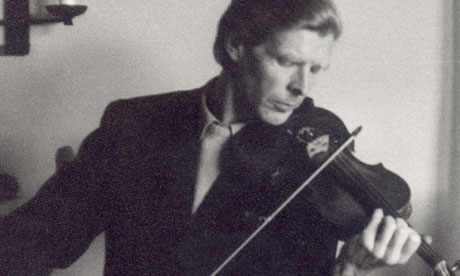
Herbert Whone was deputy leader of the Scottish National Orchestral from 1955
The violinist Herbert Whone, who has died aged 85, was an artist in the broadest of senses. His work encompassed painting in oils, photography, the writing of several books, and the playing and teaching of the violin. Probably for reasons of financial security, he never relied on art alone, although his paintings are covetable; indeed, he probably found it difficult to choose between art and music. He needed them both, and excelled in both.
Whone was born in Bingley, West Yorkshire, where his parents were both employed in the cloth mills. He was encouraged by his mother to "improve" himself culturally, and from an early age took photographs and practised the violin. After education at the Royal Manchester College of Music (now the Royal Northern College of Music) and Manchester University, he secured positions in the Royal Opera House orchestra and the BBC Symphony Orchestra, before moving to Glasgow in 1955, where he took up the position of deputy leader of the Scottish National Orchestra.
He was inspired by Glasgow's changing fortunes and painted a series of notable canvases featuring the beauty of a city in transition. His painting of trams and shipbuilding, to pick two of his fondest subjects, were presented with warmth and beauty, almost impressionistic in their depiction of glowing sunsets and use of rich colour.

Whone was born in Bingley, West Yorkshire, where his parents were both employed in the cloth mills. He was encouraged by his mother to "improve" himself culturally, and from an early age took photographs and practised the violin. After education at the Royal Manchester College of Music (now the Royal Northern College of Music) and Manchester University, he secured positions in the Royal Opera House orchestra and the BBC Symphony Orchestra, before moving to Glasgow in 1955, where he took up the position of deputy leader of the Scottish National Orchestra.
He was inspired by Glasgow's changing fortunes and painted a series of notable canvases featuring the beauty of a city in transition. His painting of trams and shipbuilding, to pick two of his fondest subjects, were presented with warmth and beauty, almost impressionistic in their depiction of glowing sunsets and use of rich colour.

Whone's Yorkshire paintings included Haworth Graveyard
In 1964, Whone took up a teaching post at Huddersfield Polytechnic. Time and money were not constraints for him, and he gave his students much more than the hour of violin lesson that they were due. In many cases he remained friends with them for life. Here was philosophy, a fascination with different religions, professionalism in art, and a tremendous skill playing the violin and teaching it to generations. He was unworldly. Indeed, one of his pupils recalled that if he turned up for a lesson evidently not in the mood, they'd go out for a cup of tea. Whone would probably pay for the tea.
He gave regular BBC recitals with Keith Swallow, but never made commercial recordings, his thoughts distilled into The Simplicity of Playing the Violin (1972), with a foreword by his friend Colin Davis and illustrated with his own drawings. Two further volumes, The Hidden Face of Music (1974) and The Integrated Violinist (1976), followed.
Whone moved to Harrogate in 1972, remaining there for the rest of his life. His photographic output included the books The Essential West Riding (1975) and Fountains Abbey (1987). Whone was a National Trust guide at Fountains Abbey for many years, and developed a Pied Piper following, rather in line with his teaching, as he conveyed his enthusiasm for this place. He held two one-man shows at Fountains Hall, in 1989 and 1995.
His diverse legacy also includes Nursery Rhymes for Adult Children (1985). He created in his photographs, his cartoons and his paintings another life professionally executed, and far beyond any amateur dabblings that a musician might deliver as an adjunct to his day job. A selection of musical cartoons, drawn during his time with the Royal Opera House orchestra, have yet to see the light of day.
Herbert Whone married Margery Reed, whom he met at university. She predeceased him. He is survived by five children, the eldest of whom, Adam, played the violin and is now a notable maker and restorer.
• Herbert Whone, violinist and artist, born 14 June 1925; died 16 May 2011
He gave regular BBC recitals with Keith Swallow, but never made commercial recordings, his thoughts distilled into The Simplicity of Playing the Violin (1972), with a foreword by his friend Colin Davis and illustrated with his own drawings. Two further volumes, The Hidden Face of Music (1974) and The Integrated Violinist (1976), followed.
Whone moved to Harrogate in 1972, remaining there for the rest of his life. His photographic output included the books The Essential West Riding (1975) and Fountains Abbey (1987). Whone was a National Trust guide at Fountains Abbey for many years, and developed a Pied Piper following, rather in line with his teaching, as he conveyed his enthusiasm for this place. He held two one-man shows at Fountains Hall, in 1989 and 1995.
His diverse legacy also includes Nursery Rhymes for Adult Children (1985). He created in his photographs, his cartoons and his paintings another life professionally executed, and far beyond any amateur dabblings that a musician might deliver as an adjunct to his day job. A selection of musical cartoons, drawn during his time with the Royal Opera House orchestra, have yet to see the light of day.
Herbert Whone married Margery Reed, whom he met at university. She predeceased him. He is survived by five children, the eldest of whom, Adam, played the violin and is now a notable maker and restorer.
• Herbert Whone, violinist and artist, born 14 June 1925; died 16 May 2011
No comments:
Post a Comment